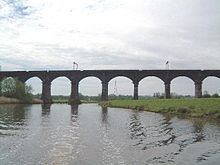Toll None Clearance below 18 m Location Dutton | Heritage status Grade II* listed Opened 4 July 1837 Total length 457 m | |
 | ||
Similar Dutton Horse Bridge, Acton swing bridge, Sankey Viaduct, Acton Bridge railway st, Summit Tunnel | ||
By south bound london midland train over dutton viaduct
Dutton Viaduct is a railway viaduct on the West Coast Main Line where it crosses the River Weaver and the Weaver Navigation between the villages of Dutton and Acton Bridge in Cheshire, England (grid reference SJ581764), near Dutton Horse Bridge. It is recorded in the National Heritage List for England as a designated Grade II* listed building.
The viaduct was built during 1836 and was completed on 9 December of that year. It was the longest viaduct on the Grand Junction Railway (GJR) and is an early example of a major railway viaduct. Its cost was £54,440 (equivalent to £4,620,000 in 2015). The engineers were Joseph Locke and George Stephenson. The contractor was William Mackenzie. It was the first project for which Thomas Brassey submitted a tender but Mackenzie's estimate was £5,000 lower. It is built in red sandstone and has 20 arches. The base of the viaduct pillars are splayed to give greater stability and 700,000 cubic feet (20,000 m3) of stone was used in its construction. The first GJR trains to carry passengers across the viaduct were run on 4 July 1837. Steel masts were added in the 1960s for electrification. The viaduct is 60 feet (18 m) high and 500 yards (457 m) long.
